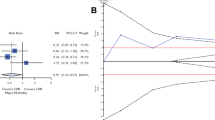Abstract
Background
The objective of the study was to assess the risk factors associated with return to the operating room in bariatric surgery patients.
Methods
Using the American College of Surgeons-National Surgical Quality Improvement Project’s participant-use file, patients who underwent laparoscopic gastric bypass (LRYGB) and adjustable gastric band (LAGB) procedures for morbid obesity were identified. Several pre-, peri-, and postoperative variables, including 30 day morbidity and mortality, were collected. The study population was divided into two groups: patients returning to the operating room (group 1), and patients not returning to the operating room (group 2). Variables analyzed included postoperative complications, overall morbidity, and mortality. Relationships between preoperative and perioperative factors leading to the return to the operating room also were analyzed.
Results
Of 28,241 (LRYGB = 18,671, LAGB = 9,570) patients included in the study, 644 (2.3 %) patients returned to the operating room. Of the study population, 30 day mortality rate was 0.13 % (37/28,241) and morbidity was 4.1 % (1,155/28,241). Patients returning to the operating room had a higher mortality [14/644 (2.2 %) vs. 23/27,597 (0.01 %); P < 0.001], and morbidity [258/644 (40 %) vs. 897/27,579 (3.3 %); P < 0.001] compared with those who did not return to the operating room. Postoperative complications (superficial wound infection, deep surgical site infection, organ space infection, pneumonia, pulmonary embolism, renal insufficiency, renal failure, septic shock, and length of stay) were significantly higher for patients who required reoperation. On multivariate logistic regression analysis, the bypass operation, bleeding disorder, patients on dialysis, preoperative hematocrit, preoperative low albumin, and length of operation were associated with increased risk of return to the operating room.
Summary
In the bariatric population, return to the operating room is associated with significantly higher morbidity and mortality. Patients who are on dialysis, have a low preoperative serum albumin, and a history of bleeding disorders have a higher chance of return to the operating room. In addition, patients who have a long operation are at increased risk for return to the operating room. Increased awareness of these predictors will be helpful to counsel the patients before the operation.
Similar content being viewed by others
References
http://www.cdc.gov/mmwr/preview/mmwrhtml/mm59e0803a1.htm. Accessed 8 May 2011
Smith BR, Schauer P, Nguyen NT (2008) Surgical approaches to the treatment of obesity: bariatric surgery. Endocrinol Metab Clin North Am 37:943–964
Simpfendorfer CH, Szomstein S, Rosenthal R (2005) Laparoscopic gastric bypass for refractory morbid obesity. Surg Clin North Am 85:119–127
Shayani V (2004) Comparison of laparoscopic gastric bypass and laparoscopic adjustable gastric banding. J Am Coll Surg 198:501–502
Saunders JK, Ballantyne GH, Belsley S, Stephens D, Trivedi A, Ewing DR, Iannace V, Capella RF, Wasielewski A, Moran S, Schmidt HJ (2007) 30-day readmission rates at a high volume bariatric surgery center: laparoscopic adjustable gastric banding, laparoscopic gastric bypass, and vertical banded gastroplasty-Roux-en-Y gastric bypass. Obes Surg 17:1171–1177
Kakarla VR, Nandipati K, Lalla M, Castro A, Merola S (2010) Are laparoscopic bariatric procedures safe in superobese (BMI ≥ 50 kg/m2) patients? An NSQIP data analysis. Surg Obes Relat Dis 7:452–458
Himpens J, Cadiere GB, Bazi M, Vouche M, Cadiere B, Dapri G (2011) Long-term outcomes of laparoscopic adjustable gastric banding. Arch Surg 146(7):802–807
Camerini G, Adami G, Marinari GM, Gianetta E, Pretolesi F, Papadia F, Marini P, Murelli F, Carlini F, Stabilini C, Sormani MP, Scopinaro N (2004) Thirteen years of follow-up in patients with adjustable silicone gastric banding for obesity: weight loss and constant rate of late specific complications. Obes Surg 14:1343–1348
Stroh C, Hohmann U, Schramm H, Meyer F, Manger T (2011) Fourteen-year long-term results after gastric banding. J Obes 2011:128451
Drolet S, Maclean AR, Myers RP, Shaheen AA, Dixon E, Donald Buie W (2010) Morbidity and mortality following colorectal surgery in patients with end-stage renal failure: a population-based study. Dis Colon Rectum 53:1508–1516
Alexander JW, Goodman HR, Hawver LR, Cardi MA (2009) Improvement and stabilization of chronic kidney disease after gastric bypass. Surg Obes Relat Dis 5:237–241
Turgeon NA, Perez SD, Mondestin M, Lin E, Davis SS, Kirk AT, Larsen CP, Pearson TC, Sweeney JF (2012) The impact of renal function on outcomes of bariatric surgery. J Am Soc Nephrol 23:885–894
Fearon KC, Luff R (2003) The nutritional management of surgical patients: enhanced recovery after surgery. Proc Nutr Soc 62:807–811
Goldfarb M, Perry Z, Hodin R, Parangi S (2011) Medical and surgical risks in thyroid surgery: lessons from the NSQIP. Ann Surg Oncol 18(13):3551–3558
Haridas M, Malangoni MA (2008) Predictive factors for surgical site infection in general surgery. Surgery 144:496–501 discussion 503
Khuri SF, Najjar SF, Daley J, Krasnicka B, Hossain M, Henderson WG, Aust JB, Bass B, Bishop MJ, Demakis J, DePalma R, Fabri PJ, Fink A, Gibbs J, Grover F, Hammermeister K, McDonald G, Neumayer L, Roswell RH, Spencer J, Turnage RH (2001) Comparison of surgical outcomes between teaching and nonteaching hospitals in the Department of Veterans Affairs. Ann Surg 234:370–382 discussion 382-383
Acknowledgments
The American College of Surgeons National Surgical Quality Improvement Program and the hospitals participating in the ACS NSQIP are the source of the data used herein; they have not verified and are not responsible for the statistical validity of the data analysis or the conclusions derived by the authors.
Disclosures
Kalyana Nandipati, Edward Lin, Farah Husain, Sebastian Perez, Jahnavi Srinivasan, John F. Sweeney, and S. Scott Davis have no conflicts of interest or financial ties to disclose.
Author information
Authors and Affiliations
Corresponding author
Rights and permissions
About this article
Cite this article
Nandipati, K., Lin, E., Husain, F. et al. Factors predicting the increased risk for return to the operating room in bariatric patients: a NSQIP database study. Surg Endosc 27, 1172–1177 (2013). https://doi.org/10.1007/s00464-012-2571-2
Received:
Accepted:
Published:
Issue Date:
DOI: https://doi.org/10.1007/s00464-012-2571-2




